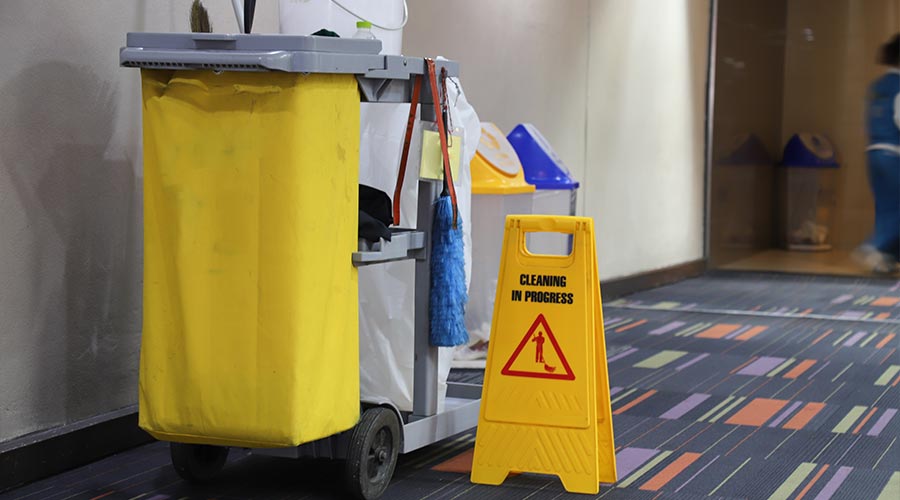
A one-size-fits-all mindset does not work for the modern cleaning cart.
“In today's market, carts are designed with a high level of modularity and customization in mind. This means that customers have the flexibility to choose from various sizes, materials, wheel configurations, handle designs, and storage accessories to create a cart that precisely meets their unique requirements,” explains Segura. “With options for adjustable shelving, specialized compartments, and ergonomic features, these customizable carts are well-suited to diverse industrial, commercial, and healthcare settings.”
One place to see customization and modularity in play is in the hospitality market.
“Housekeeping carts in hotels are large. Some are so big that I’ve seen motorized carts that help with the weight of all those linens, towels, and bath supplies,” says Schneringer.
Locking compartments are also in high demand in hotel carts, Schneringer adds. Supplies for the mini bars, for example, create an opportunity for theft, making locking capabilities essential.
Healthcare is also a sector that calls for added security. Segura notes that many carts often incorporate secure storage options for biohazard waste, as well as designated areas to house potent disinfectants and other medical-grade cleaning agents.
Even as they become more modular and secure, size matters in cleaning cart design.
“Janitor closet space is always at a premium,” Walker says. “So, carts have to be right sized to fit.”
Schneringer agrees, noting that the carts must be big enough to hold everything,but also fit in the elevators or down hallways. Manufacturers are continuing to prioritize functionality with optimally sized equipment.
One state-of-the-art way to maximize that functionality is to transform the cart from equipment that carries cleaning tools to actual cleaning equipment.
“I’ve seen carts that integrate battery operated components that spray cleaning chemicals onto surfaces,” reports Allen. “They also have shelves to hold other items. They are like a whole janitor’s closet on wheels. That’s a big design edge.”
Another high-tech improvement is incorporating technology onto the cleaning cart.
“Some models integrate wireless connectivity for inventory management,” says Segura, adding that universities, medical facilities and multi-tenant office buildings show interest in the technology. “The process involves integrating RFID scanners or barcode readers. These devices connect to a central system, enabling janitors to track items in real-time. This helps monitor inventory levels and streamline restocking processes.”
Segura notes that there is an abundance of choices in cart design today, including integrated holders for mops and brooms, ergonomic handle designs, adjustable storage compartments specifically tailored for various cleaning supplies, waste management systems — including compartments for recyclables and trash. When it comes to distributors recommending the right model for their customers, he shared a few strategies for proper navigation.
“In determining the most suitable cart forms for various end uses, it's crucial to delve into the specific requirements of each setting,” he says. “In a hospital, the choice of cart form is critical, due to the need for stringent infection control measures. Therefore, a specialized cart with sealed compartments designed to accommodate single-use microfiber mop heads and disposable cleaning supplies plays a pivotal role in preventing cross-contamination and upholding stringent hygiene protocols.”
In the dynamic environments of schools and offices, however, Segura notes that an adaptable cart with modular storage compartments and adjustable shelves is essential to cater to diverse cleaning solutions and an array of tools.
“By tailoring the cart to the distinct needs of each environment, distributors can help organizations bolster operational efficiency and establish a well-organized and functional cleaning process. This evolution reflects a concerted effort to not only streamline cleaning processes but also to prioritize the well-being of cleaning staff and maintain high standards of cleanliness.”
Finding the right match, however, requires some hands-on work beyond simply sending out a few different options to end-user customers. Most older carts just don’t meet the needs of today’s janitors, Allen stresses.
“There should be conversations and on-site visits to assess cleaning tasks, needs and available storage,” says Allen. “Then you can recommend a specific style cart for the task.”
Amy Milshtein is a freelancer based in Portland, Oregon. She is a frequent contributor to Sanitary Maintenance.
Innovation Drives Cleaning Cart Sales

 The Down and Dirty on Cleaning in Virus Season
The Down and Dirty on Cleaning in Virus Season How Surfactant Use is Expanding in Commercial Cleaning
How Surfactant Use is Expanding in Commercial Cleaning Operational Excellence Series 2025: Better Budgeting
Operational Excellence Series 2025: Better Budgeting